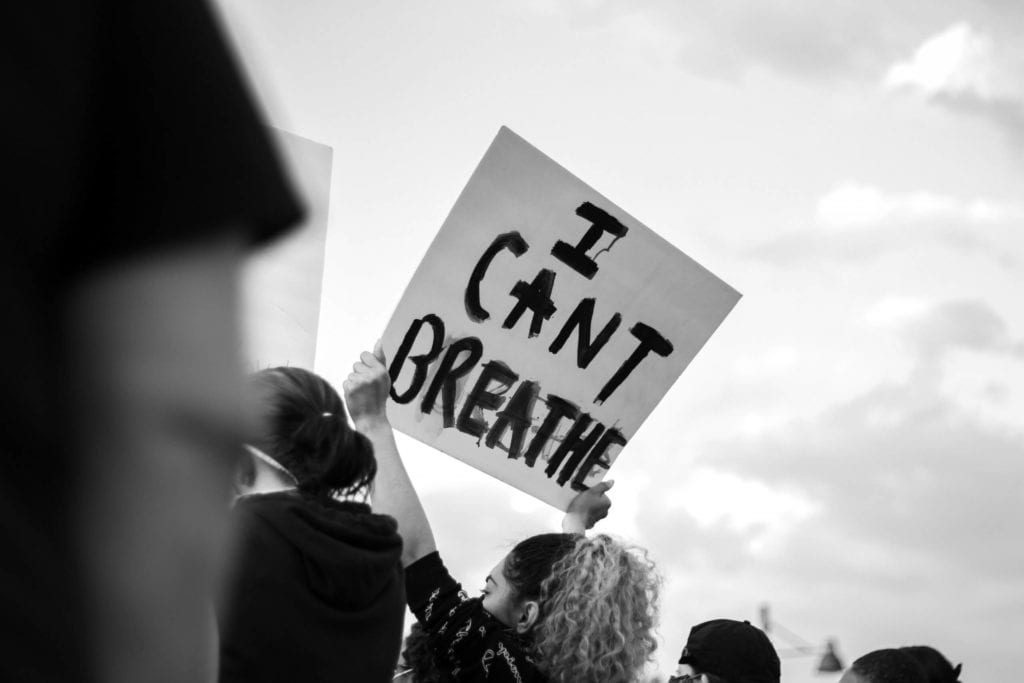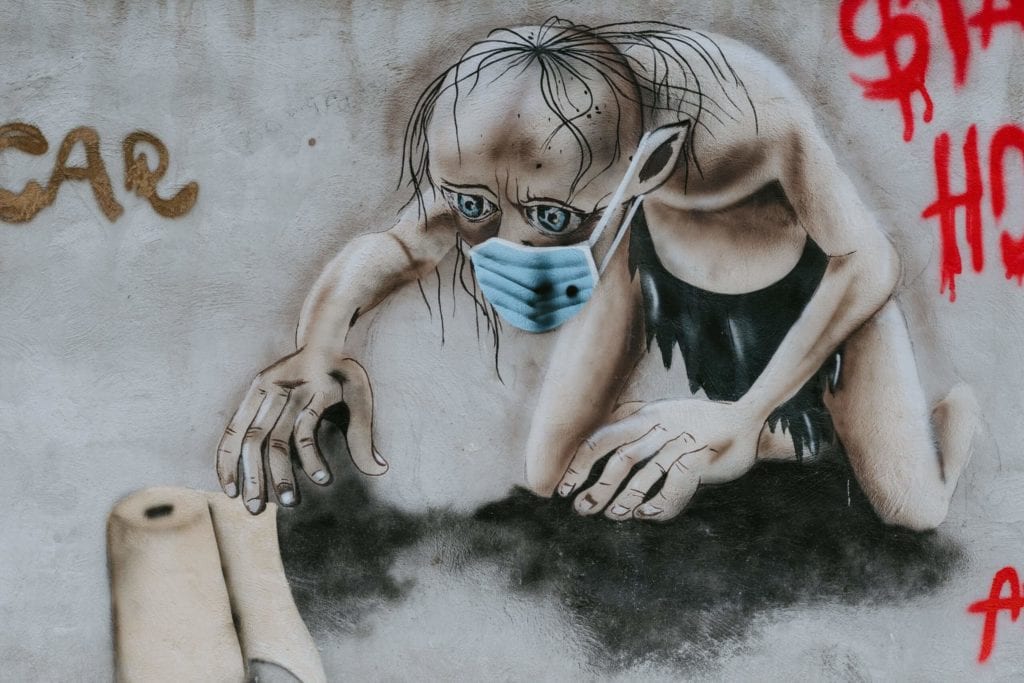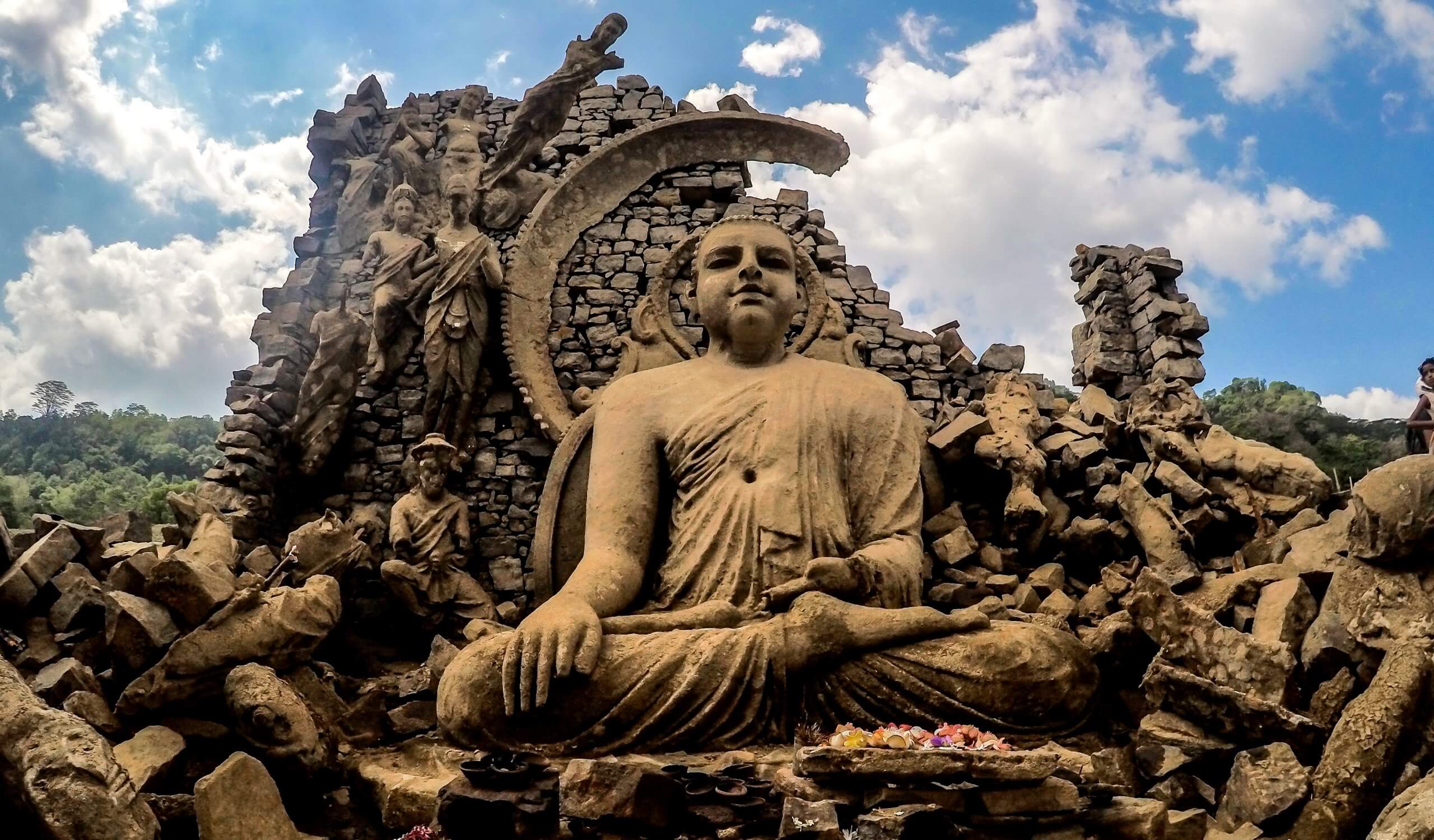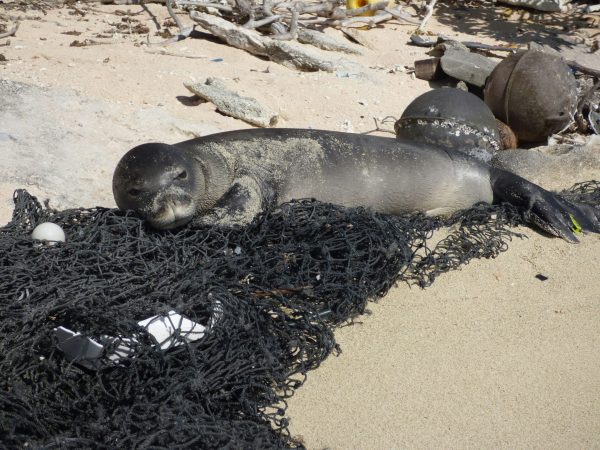‘Collapse’ is a scary word. From the Latin prefix col-, meaning ‘together,’ and the verb labi, meaning ‘to slip, slide, or fall,’ it describes a structure falling apart or inward. I hesitated using it in the title of this essay, but the Dharma was not made for tip-toeing around the truth. It was made for these times.1This essay was written on March 31, 2020 when the Covid-19 pandemic was not yet at its peak in the United States and before the uprisings catalyzed by the brutal murder of George Floyd. Although the essay speaks to the connections between racism, economic inequality and the climate and ecological crisis, if I were writing it today I would state these connections even more forcefully. I would draw on the black radical tradition, African-American and Indigenous climate activists like Mary Annaïse Heglar and Tara Houska, and analysis of right-wing climate realism (Chaudhary, “We’re Not in this Together”) to argue that black and indigenous liberation as well as broad-scale social and economic justice and equality are not merely priorities, but the essential foundations of a humane climate future. In regard to an engaged Buddhist response, I would echo Dr. Ambedkar’s call that we “Educate, Agitate, and Organize” and join Rev. angel Kyodo williams in her call for a radical dharma of collective liberation.
COVID-19 is offering us a critical opportunity to reflect on just how ill-prepared we are as a society to face the multiple crises of climate change and ecological degradation.
Collapse seems an appropriate word for a moment in which we find ourselves collectively slipping, sliding, falling towards a future that seems considerably less certain than any of us would have imagined a few weeks ago. As the coronavirus rips through our individual and collective bodies, many of us have become more acutely aware not only of the basic fragility of human life, and our own vulnerability to old age, sickness and death, but also of the precariousness and gross moral inequities of the social, economic, and political structures we have empowered and entrusted to protect and support that life. It’s hard to say at this point whether these structures are already collapsing or just dangerously close, but it is clear that they are woefully inadequate to meet the current crisis.
As much as we might prefer to learn these lessons in some other way or on some other timeline, COVID-19 is offering us a critical opportunity to reflect on just how ill-prepared we are as a society to face the multiple crises expected to increase in intensity and frequency as a result of climate change and ecological degradation. Pandemic disease is one of these. Over the last few years, we’ve already become familiar with some of the others: extreme weather events, droughts and water shortages, sea level rise, coastal and inland flooding, crop failures, soil erosion, forest fires, dramatic shifts in plant and animal ranges, insect infestations, and mass extinction of plant and animal life. As these crises intensify, food and water insecurity, internal displacement and mass human migration will present serious threats to peace and security as well as to freedom and democracy. This is why climate change is commonly understood to be a “threat multiplier.”
Before COVID-19, many scientists argued, we had less than ten years to transition our economy away from fossil fuels, radically reduce and redistribute consumption of energy and resources, and reinvent nearly every aspect of modern life, in order to keep warming within the “acceptable” range of 1.5-2 degrees Celsius above pre-industrial levels. While the impacts of a 1.5 degree warming will be severe, a 2 degree warming will be considerably worse (IPCC 2018). Currently we are on track for warming of 3-4 degrees Celsius by the end of the century, with the newer models putting that at 5 degrees and up to 10 in some regions of the globe (Vince 2019). This means that COVID-19 is not a temporary, one-off crisis, but more like a dress rehearsal for a series of environmental crises that will put even greater pressure on our social, economic and political structures. As Dharma practitioners we cannot afford to turn away from these hard truths and what they will entail in terms of human suffering.

Some of us believe that the Dharma is apolitical; that it is about sitting on a cushion and tending to our own inner states and individual actions. But this view of the Dharma ignores the fact that the world we experience is shaped by our collective actions (i.e., our collective karma)–as well as by our inaction. The COVID-19 pandemic is revealing in tragic detail just how dangerous it is to continue to cede our world to an ideology (“neoliberalism”) that confuses the unfettered accumulation of private wealth with “freedom” and societal wellbeing. Systematic prioritization of short-term profit for the few over the long-term welfare of the many (by our dominant political institutions) has led, among other things, to the erosion of our social safety nets, gross economic inequality, economic instability, the devaluation of scientific and other expertise, unreliable supply chains, depletion of medical stockpiles, mass incarceration, and a failing healthcare system—all of which will result in maximizing suffering and minimizing resilience in the face of COVID-19 and any future crisis. It is these same forces of greed, fueled by the delusion of infinite economic growth and coupled with gross moral indifference, that are accelerating our trajectory toward ecological collapse, at this very moment when we need to be slamming on the brakes.
However long our current period of physical distancing and the acute wave of the pandemic, one thing is clear: we will not be returning to “normal” after it is over. The economic, social, and psychological impacts will be with us for years, and will radically alter our political and cultural landscape—one way or another. As scary as this may feel, we need to remember that the normal to which we might long to return was barely livable for many of us, and was driving us all to disaster.
We are seeing how quickly things can fall apart, but also how quickly we can adapt; we are seeing what is essential and what we can do without.
The current disruption of “business as usual” may be the last chance we have to avert the worst-case climate scenarios, begin to restore critical portions of our rapidly deteriorating ecosystems, and correct the gross moral inequities enshrined in our social, economic, and political arrangements. As COVID-19 exposes the fragility of these arrangements, people are reexamining their relationships with each other and the Earth. Personal, cultural, and social values are shifting and new political alliances are being forged. We are seeing how quickly things can fall apart, but also how quickly we can adapt; we are seeing what is essential and what we can do without. Claims that it is too expensive or too radical to take care of each other and the Earth are losing credibility. In short, there is an opening for real transformation, but it will take tremendous creativity and courage to ensure that this is for the good. The powers that be are already on the move, taking advantage of the current crisis to increase their hold on financial and political power at the expense of other people, other species, and the ecosystems that support us all.2For a history of this “disaster capitalism” strategy, see Klein 2007.
As Dharma practitioners, it is time for us to wake up and take responsibility for the world we live in. We must decide whether we will contribute to its destruction through complacency or actively work to build a Dharmic society: a society that supports the flourishing of the Dharma by turning toward hard truths about our social and material conditions, caring for all individuals–especially the most vulnerable–and working to protect and restore the Earth.
What can we do now?
First and foremost, we can draw on our resources as Dharma practitioners to process difficult emotions, let go of fixed ideas about how things will turn out, and cultivate wholesome states that will contribute to our own wellbeing and provide support to others–no matter how things turn out. But this is not enough.
COVID-19 is teaching us how our own health is intimately connected to the health of others in our communities, all people around the world, animals, and the Earth.
Those of us who are able (in terms of health, time, financial and emotional resources, and so on) have a moral obligation to direct our energies toward cultivating the knowledge, skills, and networks we will need to build resilient communities capable of meeting the next crisis—independent of governmental aid. At the same time, we need to work together to build coalitions (e.g., with other faith and activist groups—including with those with whom we disagree) and find creative ways (see Albert Einstein Institute, “198 Methods of Non-Violent Action”) to put pressure on those in power to restore the social safety net and reverse the course on climate change.
This work will look different for each of us, but an important part of it will be shaping narratives about the meaning and lessons of COVID-19 in ways that support a Dharmic vision of the world. In a time when we are all groping to make sense of what is happening, the stories we tell ourselves and each other will play a powerful role in healing our individual and collective trauma and inspiring action.
I offer first drafts of some of the stories we might tell.
Stories of “planetary health” and interbeing
Over the past half-century, the Buddhist concept of dependent arising has been developed and adapted to convey an ecological vision and ethic. This is perhaps best captured in Thích Nhất Hạnh’s concept of interbeing, featured here (though not named) in the Buddhist Declaration on Climate Change, “The Time to Act is Now,” published ahead of the 2015 Paris conference:
Our ecological emergency is a larger version of the perennial human predicament. Both as individuals and as a species, we suffer from a sense of self that feels disconnected not only from other people but from the Earth itself. As Thích Nhất Hạnh has said, ‘We are here to awaken from the illusion of our separateness.’ We need to wake up and realize that the Earth is our mother as well as our home— and in this case the umbilical cord binding us to her cannot be severed. When the Earth becomes sick, we become sick, because we are part of her.” (Loy, Bodhi & Stanley 2015)3Also see the Global Buddhist Climate Change Collective, “Buddhist Climate Change Statement to World Leaders” (2015) and Loy 2019.
Like other ecological philosophies, this conception of interbeing weaves scientific perspectives together with our emotional and spiritual experience as embodied beings and invites us to consider the ethical demands this puts on us. This is not the way classical Buddhist texts or traditions talk about dependent arising (McMahan 2008, chapter 6), but that does not mean it is an inauthentic expression of the Dharma. It is simply an unfolding of the Dharma in response to a form of collective suffering the Buddha did not experience. (Recall that the Dharma is not dependent on discovery or articulation by a Buddha.)
To help make sense of the COVID-19 crisis and how it is revealing a brokenness in our relationship to each other and the Earth, we can frame it in the context of the interbeing of human and “planetary health.” Planetary health is a new interdisciplinary field that seeks to understand human health as intimately connected to the health of the Earth’s ecosystems (Dunk et al. 2019), and advocates for the expansion of medical ethics to include our relationship with the Earth as well as to future generations (Goldberg and Patz 2015).

© roya ann miller from Unsplash
Although there is no direct connection between COVID-19 and climate change, the way the pandemic originated and has been transmitted is directly connected to how we live in relation to the Earth (and each other). Novel animal-born (zoonotic) viruses like it, to which we have not had time to develop immunity, spillover into the human population as a result of the destruction of natural habitats, industrial animal agriculture, trade in wild animals, over-crowded “wet markets,” and protein scarcity. Recent viral pandemics–the 1918 ‘Spanish flu’ (H1N1), HIV/AIDS, ‘swine flu’ (another strain of H1N1), and Ebola, as well as coronaviruses (SARS and MERS)—are all suspected to originate from such poor ecological practices (see Quammen 2013 & Carrington 2020).
Once such a virus spills over into the human population, population density and the speed and frequency at which we move our bodies and commodities across the Earth (combined with our preparedness–or lack thereof) help it spread (Ehrlich 2020). Loss of biodiversity also plays a critical role in the origination and spread of disease insofar as healthy, intact and complex ecosystems provide a natural immunity to disease compared to depleted and simplified ecosystems, which tend to promote disease (Vidal 2020). Healthy ecosystems are also richer and more abundant in nutrition.
Although COVID-19 and other recent viral pandemics are not directly related to climate change, warming temperatures play a major role in the spread of other zoonotic diseases, especially those transferred through insect vectors (e.g., Lyme, West Nile, Zika, Eastern equine encephalitis). Warming temperatures also contribute to the spread of disease as a result of mass animal migration (owing to contact between species with no previous contact and ecological disequilibrium), release of pathogens through the melting of arctic ice and permafrost, and disturbances to the internal equilibrium of animal bodies—such that formerly benign bacteria, parasites, fungi, or viruses turn pathogenic (Wells 2019, “Plagues of Warming”). As temperatures rise, we can also expect to see an increase in permanent disability and death due to heat stress and heat stroke.
Degradation of nutrients due to industrial farming and pollution also contribute to epidemics of non-communicable diseases such as heart disease, cancer, diabetes, kidney disease, and a variety of respiratory and mental illnesses (Salas et al 2019). Air pollution alone kills seven million of us every year and impairs our ability to think (Gibbens 2018), while the production, use, and waste of fossil fuel-based plastics pose distinct risks to nearly every system in the human body (Azoulay et al 2019). Such ill-health makes us all vulnerable—especially in a crisis, but is disproportionately visited on the poor, people of color, indigenous communities, and the global south—the people least responsible for the climate and ecological crisis.
COVID-19 offers an opportunity to reflect upon how scaling back privileged lifestyles and redistributing resources is not only moral, but also likely to be far less painful for everyone than the social and economic instability that will result from continued ecological destruction combined with inequity.
From the perspective of the interbeing of human and planetary health, COVID-19 is teaching us how our own health is intimately connected to the health of others in our communities, all people around the world, animals, and the Earth. It is teaching us the wisdom of slowing down and engaging in smaller scale, local and regenerative agriculture– not only in order to reduce the spillover and spread of disease and help heal the Earth, but to ensure access to food when national and global supply chains are disrupted. In other words, COVID-19 is teaching us the importance of building resilience in our social and natural ecosystems (Lerch 2017). In regard to our practice of the Dharma, it may be recommending a shift from a focus on self-care and personal transformation to a focus on community and ecological resilience—especially in our practice as sanghas.
As we contemplate the interbeing of human and planetary health, we have much to learn from the insights of modern environmental science and medicine (and the softer sciences such as sociology, social psychology, and economics), but this need not entail that we accept the philosophical materialism that informs culturally dominant conceptions of science (i.e., “scientific materialism”). Materialism and Buddhism are diametrically opposed. While materialism understands the world as ultimately composed of physical properties and processes that exist independently of our experience, and takes consciousness to be an illusory or real byproduct (an epiphenomenon or emergent property) of these processes, virtually all Buddhist traditions prioritize the reality and primacy of consciousness and understand the world (loka) to be shaped through our actions (karma). In other words, despite differences in how Buddhist traditions conceive of the relationship between mind, action and world, they generally agree that our relationship to the world is co-creative and ethically significant (e.g., see Anālayo 2019 on the Cakkavatti Sutta DN 26). Materialism has no such ethical vision and underlies the ecologically pernicious conception of the Earth as a heap of “resources” to be extracted for profit (as well as the socially pernicious idea that human beings are likewise resources—for the extraction of labor and wealth, i.e., “workers” and “consumers”).
Although Buddhism is not compatible with materialism, historically it has accommodated a broad variety of traditional and animist views. As we develop an ethic based on the interbeing of human and planetary health, we might consider the value of re-sacralizing our relationship with the Earth by drawing on indigenous wisdom and ritual. In our stories of interbeing, for example, we might not only speak of the Earth as a living being and as “mother,” as in the Buddhist declaration quoted above, but also speak of (or address) a variety of other-than-human beings, including ecosystems, as if they were persons with whom we have reciprocal ethical relationships. This way of speaking carries a moral imperative and is part of the logic supporting recent initiatives to grant legal rights to rivers (Riederer 2018), and to make “ecocide” a crime akin to genocide (Lennard 2019).
Stories of a Dharmic society
As we undergo this period of rapid cultural change and collective trauma, how we talk about our relationships to each other may have a lasting impact on our social psyche. This is why, for example, so many of us (Buddhist and non-Buddhist alike) are resisting using the Orwellian-sounding phrase “social distancing” to describe the highly pro-social practice of physical distancing that is likely to define our lives for some time to come. Acceptable substitutes might be “physical distancing” or “distance socializing”—akin to “distance learning” already in our lexicon. (As suggested above, other words we might consider revising include “worker” and “consumer”—what do these mean for a world in which a third of us may be unemployed and there is an existential imperative to radically reduce consumption? “Lockdown” with its associations to the racist carceral state is also troubling.)
As we experience the best and worst of what humanity has to offer over the coming months, and struggle to make sense of it, it will also be important to consider what kinds of qualities and values our stories promote. Stories about the creative ways people are finding to support each other’s emotional and physical health while physically separated, stories that celebrate acts of kindness and generosity, and stories that acknowledge suffering help support Dharmic qualities of generosity and compassion. Even when the subject is difficult, they are uplifting and brighten the heart-and-mind.
One of the things that finally “activated” me in regard to the climate and ecological crisis was my realization that there is just no freedom to be had in turning away from the truth of how dire the situation really is.
Promoting Dharmic qualities may be more challenging when we need to tell stories about the darker sides of human behavior. Fortunately, Buddhist traditions offer some relevant advice. Both Theravāda and Mahāyāna Buddhism encourage us to celebrate wholesome actions, and to take responsibility for our own unwholesome actions, but advise that we regard others as not in control of their unwholesome actions (e.g., Buddhaghosa 2010, chapter IX discussion of loving kindness and Śāntideva 2008, chapter 6 discussion of patience). This may seem a bit counter-intuitive, but it makes sense when we consider that (in contrast to some theological traditions), Buddhism is not centrally concerned with moral responsibility, with who is to blame or who is deserving of punishment, but rather with what we can do to become free from suffering.
By praising wholesome actions in others we encourage wholesome, freedom-promoting states in others as well as ourselves, and empower ourselves to take such actions (which we are advised to recognize and enjoy but not get puffed up over). When we take responsibility for our unwholesome actions by seeking to understand the unwholesome states that led to them, we are empowered to abandon these freedom-inhibiting states. When it comes to the unwholesome actions of others, however, imagining these to result from causes and conditions beyond the individual’s control empowers us to respond to these actions with compassion rather than anger. This contributes to our own freedom as well as to societal harmony, which helps promote Dharmic qualities in all individuals.

© Ashkan Forouzani from Unsplash
Tracing harmful actions to impersonal causes can also help us diagnose the structural conditions that promote suffering—a hallmark of some versions of socially engaged Buddhism. To take a relatively mild example, consider the hoarding of toilet paper. When we see such behavior we may be tempted to blame it on the selfishness of the individual, or the basic delusion of self-grasping. However, this individualizes and spiritualizes what is primarily a social problem.4A similar logic underlies critiques of the corporate marketing of mindfulness with the insidious message that if you are unhappy it isn’t because of the fundamental brokenness of our social compact, but because you can’t manage your internal states. See Purser 2019. It overlooks the fact that while we all have a tendency toward self-grasping, societal structures can help ameliorate or intensify this tendency. In other words, hoarding is not the inevitable result of an irredeemable human nature, but the predictable result of living in a society in which the individual is made solely responsible for procuring the basic requisites of life (food, clothing, shelter, and medicine), and forced to compete with others to do so. Such behavior is further compounded by a system that is structurally opposed to long-term planning and preparedness due to institutionalized greed, hatred, and delusion.
Instead of telling stories that condemn individuals for the desperate actions this situation compels, we might tell stories that question the nature of our present social compact (Isn’t the point of a society to ensure the welfare and safety of all its members? Isn’t a society that has the means but fails to do so grossly immoral?). We can also tell stories that help us imagine how it might be otherwise. One of the stories people were telling each other this past week was about the time a student asked the anthropologist Margaret Mead what, in her view, was the first sign of civilization. The student wondered if this might be pottery, a particular kind of tool, or evidence of agriculture. Mead shook her head and held up a human femur that had been broken and healed over. She explained that this was the first sign of a civilized society because caring for a person while they healed from such an injury would have required cooperation, tenderness, and selflessness.5This story was making the rounds on social media last week and appeared in an essay in The Guardian (Blumenfeld 2020). I couldn’t track down the original telling beyond an extended quote in Brand and Yancey 1993, 274-275. This sounds like a Dharmic society to me.6Bodhi 2016, Buddhist Teachings on Social and Communal Harmony provides some of the basic principles. Also relevant at this time is Anālayo 2016, Mindfully Facing Disease and Death, which addresses caretaking of the sick specifically in chapter IV.
Stories of renunciation
The Earth simply cannot continue to support the lifestyles of industrial nations in the global north.
Many of the stories Buddhists and non-Buddhists alike have been telling about the COVID-19 crisis have concerned renunciation and the ways in which the sudden transformation of our lives has forced us to reconsider what is essential. This creates an opening in our collective consciousness to imagine how we might be able to adapt to the changes necessary to reverse the course on climate—changes that now seem considerably more gradual and less drastic by comparison. Forced renunciation has also created an opening to imagine a different kind of economy: one based on the security of social, psychological, and ecological wellbeing instead of on uncontrolled greed and the delusion of perpetual growth.
As COVID-19 forces a radical moral reckoning with the unequal distribution of suffering in our society, as well as with how gross social and economic inequality and injustice are antagonistic to our collective resilience, there is also an opening to tell more truthful stories about how addressing the climate and ecological crisis will require redistribution of wealth and resources within nations as well as between the global north and south. Study after study has shown that between population growth and consumption rates, the Earth simply cannot continue to support the lifestyles of industrial nations in the global north. Even if renewable energy and a doubling of efficiency in our use of resources helps reverse the course on climate change, we will soon (by 2050) reach the limits of the resources needed to produce these technologies if we do not scale back consumption and redistribute resources (Hickel 2018). COVID-19 offers an opportunity to reflect upon how scaling back privileged lifestyles and redistributing resources is not only moral, but also likely to be far less painful for everyone than the social and economic instability that will result from continued ecological destruction combined with inequity.
Stories of freedom and letting go
These stories of planetary health and interbeing, Dharmic society, and renunciation are just some of the stories we might tell ourselves and others as we try to make sense of our experience with COVID-19 and work to bring about a more Dharmic world. However, the most important stories will concern freedom and letting go, the basic story of the Dharma.
One of the things that finally “activated” me in regard to the climate and ecological crisis was my realization that there is just no freedom to be had in turning away from the truth of how dire the situation really is. Any time I tried to put it out of my mind or excuse myself from taking action, it was because of one or more of the three poisons was at work. There was greed in not wanting to kill my mood, apathy in closing my heart to suffering, and delusion in pretending things are different than they really are. In other words, trying to “spiritually bypass” the particular suffering of this time, a suffering that I too am feeling in the form of separation (from myself, other beings, the Earth), was not going to work.
Joanna Macy has often said, “The most radical thing any of us can do at this time is to be fully present to what is happening in the world.” I think that is true. The strange thing is that while there is no freedom to be had in turning away from our collective suffering, freedom is not contingent on the ultimate success of our efforts to remove it. Freedom is found in renunciation: renouncing those delusions and attachments that block us from tending to the world, and also the delusion and attachment that creates a fixed idea of how it will all turn out. In sum, in the midst of great instability, uncertainty and suffering, we gotta try like crazy while also letting go. If that sounds familiar, it’s because the Dharma was made for these times.
This article was originally published by the Barre Center for Buddhist Studies. It is reprinted here with permission.
References
- 1This essay was written on March 31, 2020 when the Covid-19 pandemic was not yet at its peak in the United States and before the uprisings catalyzed by the brutal murder of George Floyd. Although the essay speaks to the connections between racism, economic inequality and the climate and ecological crisis, if I were writing it today I would state these connections even more forcefully. I would draw on the black radical tradition, African-American and Indigenous climate activists like Mary Annaïse Heglar and Tara Houska, and analysis of right-wing climate realism (Chaudhary, “We’re Not in this Together”) to argue that black and indigenous liberation as well as broad-scale social and economic justice and equality are not merely priorities, but the essential foundations of a humane climate future. In regard to an engaged Buddhist response, I would echo Dr. Ambedkar’s call that we “Educate, Agitate, and Organize” and join Rev. angel Kyodo williams in her call for a radical dharma of collective liberation.
- 2For a history of this “disaster capitalism” strategy, see Klein 2007.
- 3Also see the Global Buddhist Climate Change Collective, “Buddhist Climate Change Statement to World Leaders” (2015) and Loy 2019.
- 4A similar logic underlies critiques of the corporate marketing of mindfulness with the insidious message that if you are unhappy it isn’t because of the fundamental brokenness of our social compact, but because you can’t manage your internal states. See Purser 2019.
- 5This story was making the rounds on social media last week and appeared in an essay in The Guardian (Blumenfeld 2020). I couldn’t track down the original telling beyond an extended quote in Brand and Yancey 1993, 274-275.
- 6Bodhi 2016, Buddhist Teachings on Social and Communal Harmony provides some of the basic principles. Also relevant at this time is Anālayo 2016, Mindfully Facing Disease and Death, which addresses caretaking of the sick specifically in chapter IV.







